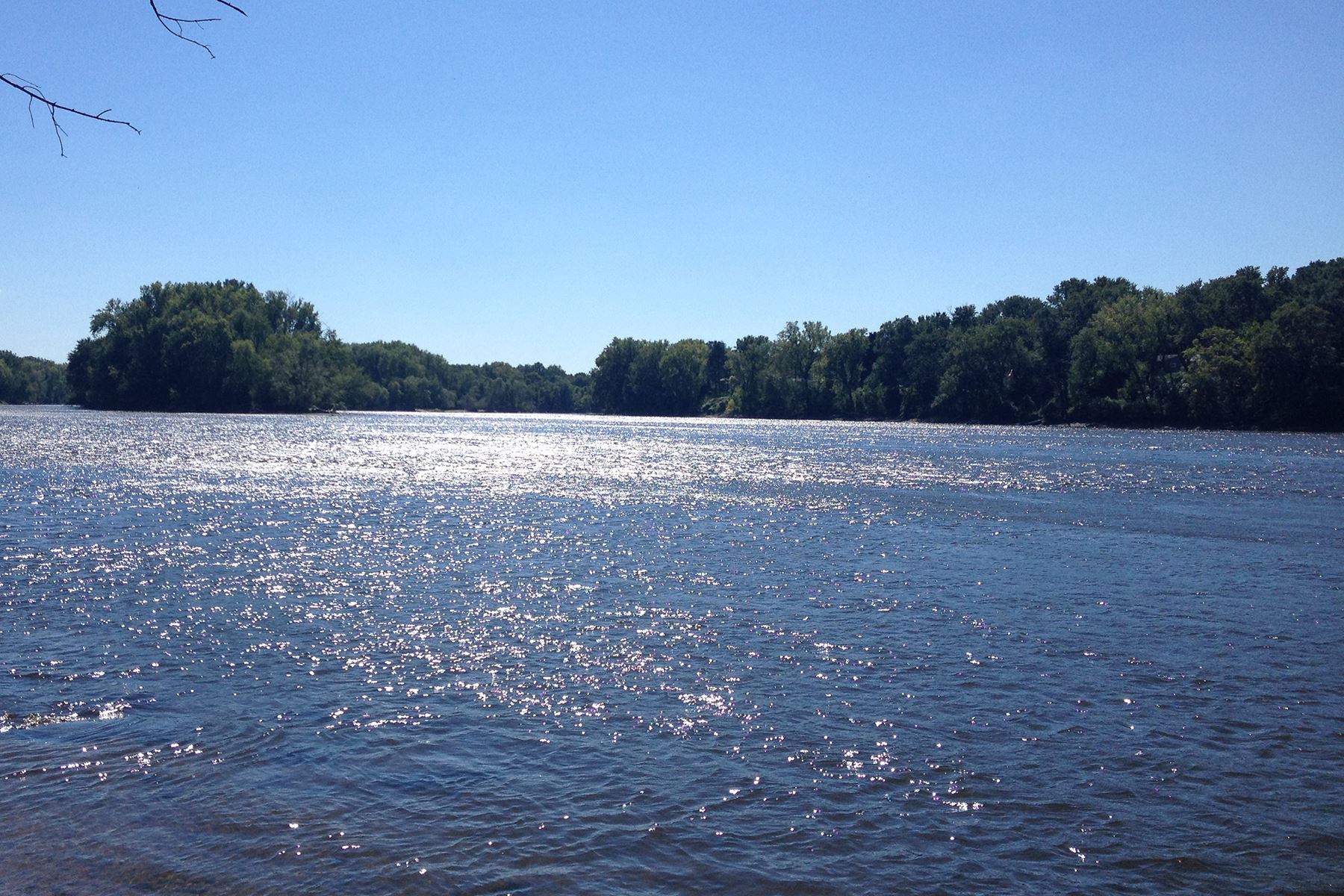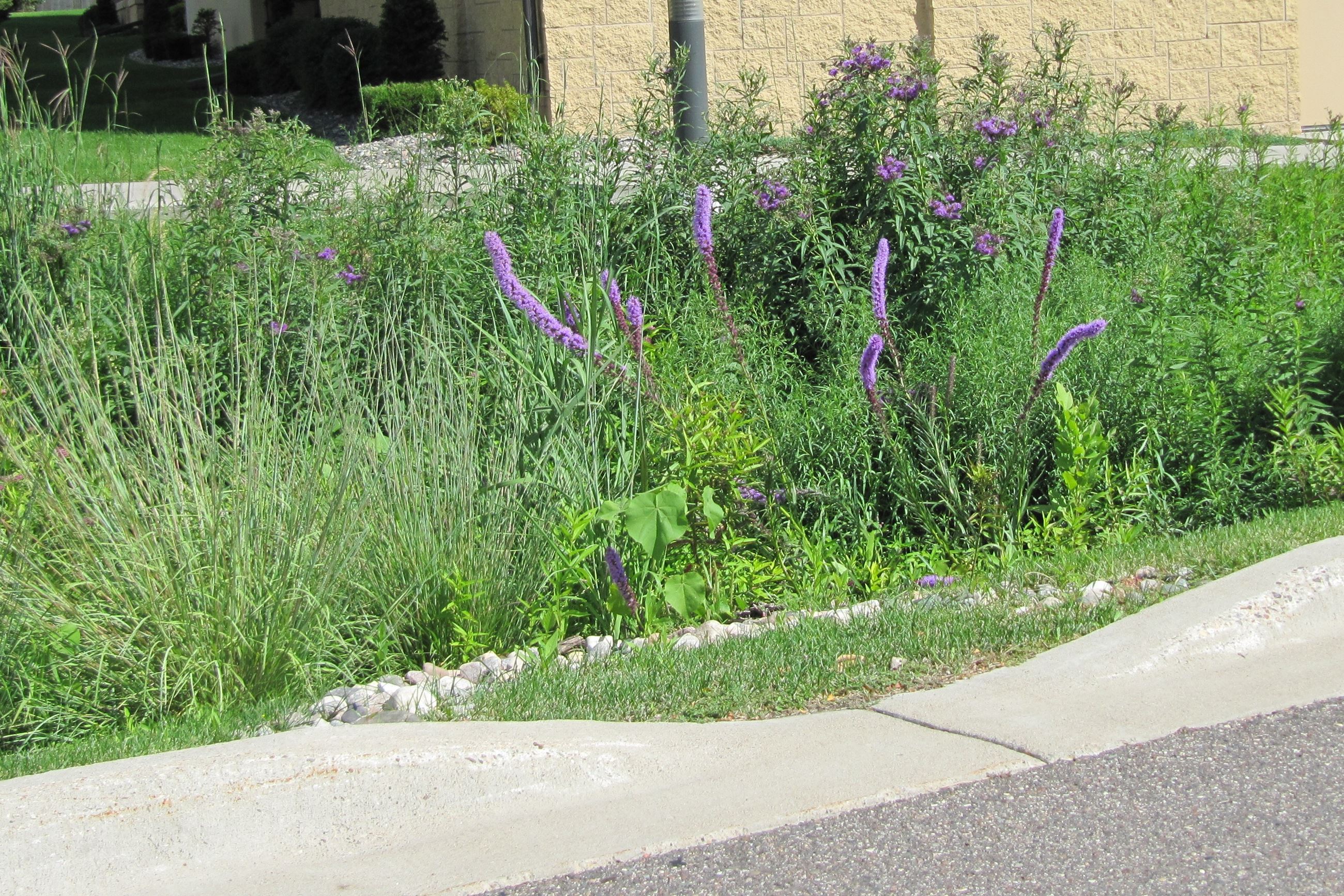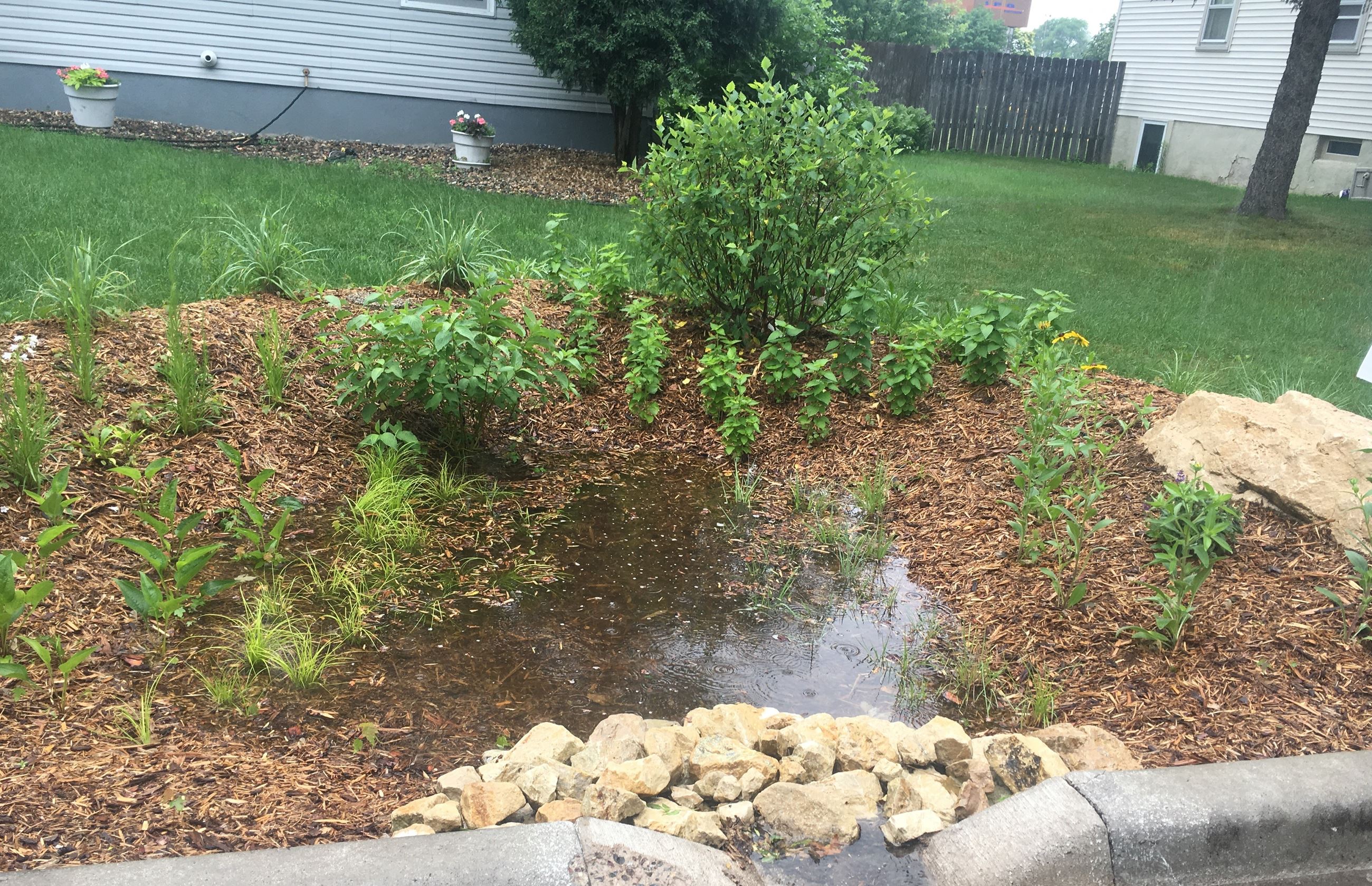Stormwater
Do you know where Fridley's stormwater goes? If rain falls on pervious surfaces (grass, landscaping, trees), it can infiltrate back into the ground, but rain that falls on impervious surfaces (concrete, asphalt, roofs) runs off into the stormsewer system. Water that enters the stormsewer system doesn't just disappear- it is conveyed by pipe to a downstream body of water.
Watersheds in Fridley
 Most of the stormwater runoff in Fridley eventually reaches the Mississippi River, but the path it takes depends on the watershed. A watershed is all the land that drains to a particular body of water. Learn more about watersheds by watching a short video.
Most of the stormwater runoff in Fridley eventually reaches the Mississippi River, but the path it takes depends on the watershed. A watershed is all the land that drains to a particular body of water. Learn more about watersheds by watching a short video.
The City of Fridley is comprised of three watersheds that are overseen by three different organizations: Coon Creek Watershed, Rice Creek Watershed, and Mississippi Watershed. Find out what watershed you are in by searching the Fridley Neighborhood Map.
Protecting Fridley's Waters
Once water enters the stormsewer system, it is not treated before being discharged into our waterbodies. Therefore, it's important to make sure that water is as clean as possible before it goes down the stormdrain. As a property owner, please do your part to protect our waters:
Keep the Drains Clear
Leaves and grass clippings add phosphorus to our waters and can block drains, leading to flooding. Make sure you sweep up any debris from your lawn that enters the street. You can now even adopt your own drain to keep it clear of pollutants. Learn more at adopt-a-drain.org.
Keep the Water Clean
Fertilizers, salt and pet waste are three common pollutants that wash off yards into storm drains and pollute our waters.
- If you choose to fertilize, do it in the fall when it will be more effective and sweep up excess fertilizer.
- Learn how to salt smartly with guidance from the Mississippi Watershed Management Organization.
- Always remember to scoop the poop after your pet. If you wouldn't want to swim in it, don't let it enter the drain.
Keep Your Lawn Healthy
There are plenty of ways to reduce your lawn's impact on our water resources. Consider switching your lawn to native plants, a pollinator garden, or turf alternatives. If you don't want to make the switch, keep your grass to three inches or higher to promote a healthier root system and reduce weeds.
Stormwater Pollution Prevention MS4 Permit
The City of Fridley's stormwater system is a small Municipal Separate Storm Sewer System (MS4) permitted through the Minnesota Pollution Control Agency. A Stormwater Pollution Prevention Plan (SWPPP) outlines the activities that the City undertakes as part of this permit. These activities are intended to promote maintenance of water quality to the waters that the City of Fridley's stormwater system discharges to.
Our MS4 permit application details the steps and plans we have in regards to stormwater management including, but not limited to, public education and involvement. In an effort to give you access to our stormwater permitting requirements in a way that is convenient to you and to comply with Minnesota Pollution Control Agency requirements, we have placed it online.
Read our MS4 Permit Application for coverage under the 2020 MS4 General Permit.(PDF, 1MB)
Questions
If you have any questions, concerns or would like to make comments on these plans or this process, please email Rachel Workin, Environmental Planner, or call 763-572-3594.
Additional Resources
More information on stormwater can be found at the following links:
Report an Illicit Discharge
Only stormwater should be entering the storm sewer system. If you notice pollutants (oil, grass clippings, etc.) entering a storm drain, please report it as an illicit discharge by calling 763-572-3566.
Rain Gardens
 One of the best ways that you can improve water quality in Fridley is to let stormwater return into the ground naturally rather than runoff into the stormsewer. Rain gardens are planted basins that are designed to treat and infiltrate water. Rain gardens can also add beautiful landscaping to your yard.
One of the best ways that you can improve water quality in Fridley is to let stormwater return into the ground naturally rather than runoff into the stormsewer. Rain gardens are planted basins that are designed to treat and infiltrate water. Rain gardens can also add beautiful landscaping to your yard.
What is a Rain Garden?
Rain gardens are landscaped depressions that are designed to capture and treat stormwater runoff.
Stormwater runoff usually travels over hard surfaces, such as driveways and roads, into the stormsewer system. Runoff in the stormsewer is discharged, untreated, into downstream water bodies such as Rice Creek, Moore Lake, or the Mississippi River. However, rain gardens can capture this runoff and allow it to naturally infiltrate through the soil instead.
By allowing water to naturally infiltrate through the soil, rain gardens can reduce flooding and remove pollutants such as sediment and phosphorus. This improves the quality of our water! Rain gardens can also be landscaped with native, pollinator-friendly plants to support our amazing pollinators!

Dry Rain Garden

Raingarden filtering water
Installing Your Rain Garden
If you're interested in improving water quality, a rain garden may be a great addition to your yard! Rain gardens can be designed to capture runoff from your roof and driveway or from the street using a curb-cut(PDF, 5MB).
Small rain gardens can be installed by hand, but you may want some help for a larger project. Your watershed district may offer technical or financial assistance:
Property Assessment
Not all properties are suitable for rain gardens. Anoka Conservation District offers site assessment to help determine if and where a rain garden should be installed on your yard.
Technical and Financial Support
Grant funding may be available to install a rain garden on your property. If you're interested in a curb-cut rain garden to treat runoff from your street. Contact Rachel Workin, Environmental Planner at 763-572-3594 or Rachel.Workin@fridleymn.gov to discuss available technical and financial support.
Maintaining Your Rain Garden
Like any landscaped area, rain gardens need to be maintained. Keeping all inlets clear and weeding your rain garden goes a long way to ensuring that it stays functional and looks great. Check out a list of maintenance tips(PDF, 338KB) from Metro Blooms as well as upcoming workshops on rain garden maintenance.
Additional Information
Go Further
Minnesota Water Stewards is a multi-week course offered by local watershed districts and the Freshwater Society that teaches about Best Management Practices and develops water quality leaders. If you're passionate about water quality, consider applying to be a Minnesota Water Steward.
Stormwater Projects
The City of Fridley has a number of stormwater-related projects in place to help reduce pollution and manage runoff.
Farr Lake Study
The City of Fridley is working with Barr Engineering to perform a study of the stormwater management system surrounding Farr Lake. This system is comprised of 10 ponds, wetlands, and dry basins.
Questions? Contact the Engineering Division by email or phone at 763-572-3554.
Farr Lake Storyboard
Scroll through the Farr Lake Storyboard to learn how the stormsewer system carries stormwater runoff from neighborhood streets to Farr Lake, Rice Creek, and the Mississippi River
Farr Lake Resident Meeting Alternatives Review
Review the PowerPoint that outlines the steps taken in the Farr Lake Study to date, as well as proposed solutions. You can also watch the resident presentation video.
East Moore Lake Biochar and Iron-Enhanced Sand Filter
This filter will treat stormwater runoff from a 94-acre area surrounding Moore Lake to help improve water quality. Water from the lake and storm sewer system will be pumped through the filter to remove pollutants including nutrients, bacteria, and sediment. Other water quality improvements include the installation of a hydrodynamic separator, a detention area, and pollinator plantings.
Moore Lake was designated as an impaired water for excess nutrients by the Minnesota Pollution Control Agency in 2002. Common sources of nutrients into the lake include fertilizer runoff and leaves entering the storm sewer system. The improved water quality resulting from this project will be an important part of the overall effort to revitalize Moore Lake.
For more information, please contact the City of Fridley's Engineering Department at 763-572-3554 or by email at web-FridleyEngineering@FridleyMN.gov.
Apex Pond Enhancement Project
The City of Fridley worked closely with our local district partners, the Anoka Conservation District and Coon Creek Watershed District to develop plans for Apex Pond. Apex Pond was constructed in 1999 and was last cleaned in 2010. In 2023, a contractor dredged the pond of overgrown vegetations, broken trees, debris, and sediment buildup that accumulated over the years.
The second phase of the project included enhancing the pond by increasing the stormwater storage volume. This added flood storage and reduced overall maintenance. Additionally, new shrub plantings were installed around the pond.
For more information, please contact the City of Fridley's Engineering Department at 763-572-3554 or by email at web-FridleyEngineering@FridleyMN.gov.